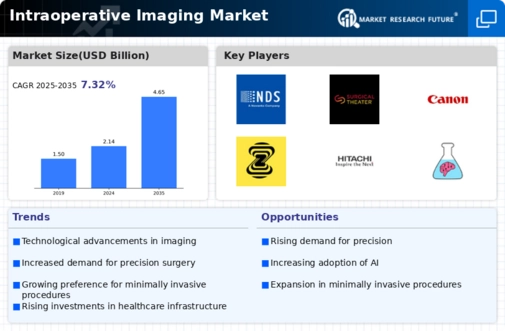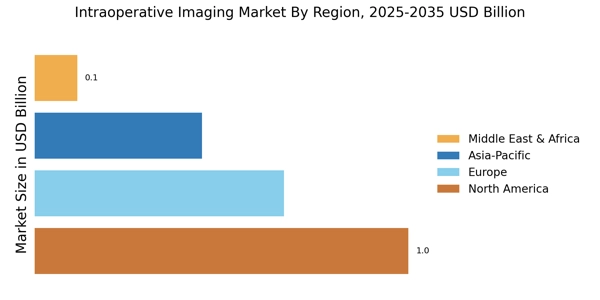Growing Focus on Patient Safety
The Intraoperative Imaging Market is increasingly shaped by a heightened focus on patient safety. As healthcare providers prioritize minimizing surgical errors and improving patient outcomes, the integration of advanced imaging technologies becomes essential. Intraoperative imaging allows for real-time visualization of anatomical structures, which can significantly reduce the risk of complications during surgery. Recent studies suggest that the use of intraoperative imaging can decrease the rate of surgical errors by up to 30%. This emphasis on safety not only enhances the quality of care but also aligns with regulatory requirements aimed at improving surgical standards. Consequently, the Intraoperative Imaging Market is likely to see sustained growth as hospitals and surgical centers invest in these technologies to ensure optimal patient safety.
Increase in Surgical Procedures
The Intraoperative Imaging Market is significantly influenced by the rising number of surgical procedures performed annually. As healthcare systems evolve, there is a marked increase in both elective and emergency surgeries. This trend is further supported by advancements in surgical techniques and technologies, which have made procedures safer and more efficient. For instance, the number of minimally invasive surgeries has increased, necessitating the use of intraoperative imaging to guide surgeons. Data indicates that the surgical volume is expected to grow by 5% annually, thereby driving the demand for intraoperative imaging solutions. This increase in surgical activity underscores the critical role of imaging technologies in enhancing surgical precision and patient outcomes.
Rising Demand for Precision Surgery
The Intraoperative Imaging Market is experiencing a notable surge in demand for precision surgery. Surgeons increasingly require real-time imaging to enhance accuracy during procedures. This demand is driven by the growing prevalence of complex surgical cases, where traditional imaging methods may fall short. According to recent data, the market for intraoperative imaging is projected to reach USD 3.5 billion by 2026, reflecting a compound annual growth rate of approximately 8.5%. This growth is indicative of the industry's shift towards technologies that facilitate better surgical outcomes, thereby improving patient safety and reducing recovery times. As healthcare providers seek to adopt advanced imaging solutions, the Intraoperative Imaging Market is poised for substantial expansion.
Rising Incidence of Chronic Diseases
The Intraoperative Imaging Market is significantly impacted by the rising incidence of chronic diseases, which often necessitate surgical intervention. Conditions such as cancer, cardiovascular diseases, and orthopedic disorders are on the rise, leading to an increased demand for surgical procedures. This trend is further compounded by an aging population, which is more susceptible to chronic health issues. Data indicates that the prevalence of chronic diseases is expected to increase by 15% over the next decade, thereby driving the need for effective surgical solutions. Intraoperative imaging plays a crucial role in these surgeries, providing surgeons with the necessary tools to navigate complex anatomical structures. As the healthcare sector adapts to these challenges, the Intraoperative Imaging Market is likely to experience robust growth.
Technological Innovations in Imaging Systems
The Intraoperative Imaging Market is propelled by continuous technological innovations in imaging systems. Advancements in modalities such as MRI, CT, and ultrasound are enhancing the capabilities of intraoperative imaging. These innovations allow for higher resolution images and faster processing times, which are crucial during surgical procedures. For example, the introduction of portable imaging systems has made it feasible to obtain high-quality images in the operating room without the need for extensive setup. The market is expected to witness a growth rate of 7% annually, driven by these technological advancements. As surgical teams increasingly rely on sophisticated imaging tools, the Intraoperative Imaging Market is likely to expand, reflecting the ongoing evolution of surgical practices.


















Leave a Comment